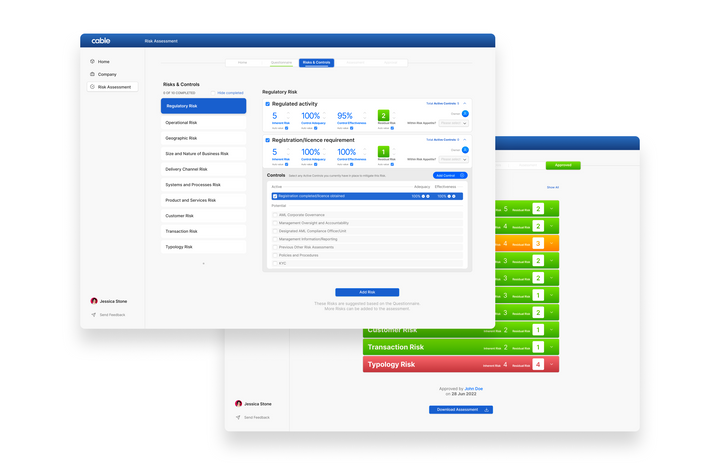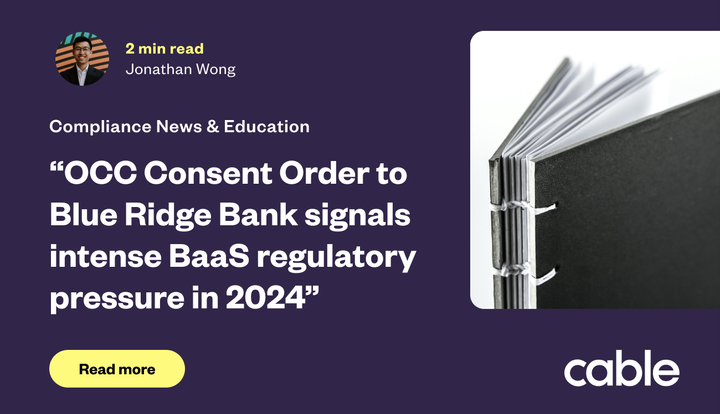How Partner Banks Can Manage Increased Regulatory Scrutiny on BaaS & Fintech Relationships

Two partner banks with rapidly growing BaaS businesses are facing serious regulatory concerns following supervisory examinations, according to new reporting from industry sources. Other partner banks are reportedly slowing or stopping onboarding of new BaaS and fintech clients, or even ending existing relationships.
All signs point to intensifying regulatory scrutiny of banks’ oversight of their BaaS and fintech partnerships.
Partner banks must improve compliance oversight of their Baas and fintech relationships or risk being cut off from these lines of business. The stakes are too high to get this wrong.
What’s causing the increased scrutiny?
Many partner banks are small, local institutions providing back-end banking services to customer-focused, hyper-growth BaaS and fintech partners. This business is often their primary avenue for increasing revenue.
But as regulated entities, partner banks are on the hook for complying with financial crime obligations and other rules. Part of their responsibility is checking that their partners do the same. This means many partner banks – whose processes and technology are often designed with low customer numbers and minimal growth in mind – need to figure out better ways to manage risks arising from rapidly expanding customer portfolios from their BaaS and fintech clients.
As more and more non-banks offer banking services to customers, regulators are looking harder at these arrangements and partner banks’ oversight of their partners. Some have voiced concerns that these partnerships “allow fintechs to skirt a host of rules at the expense of customer protection and bank safety and soundness.”
If partner banks ignore regulators’ concerns, the costs can be disastrous – both their main revenue strategy and their regulated status will be put in jeopardy.
How can partner banks stay ahead of regulatory concerns?
Here are four steps partner banks should take to prepare themselves for the uptick in regulatory scrutiny.
Understand BaaS and fintech partners’ different risk profiles.
Each BaaS and fintech client has a different risk profile – their products and services, customer base, and transaction volumes and types vary. This adds complexity to partner banks’ compliance oversight task.
Partner banks can’t take generic, broad-brush approaches to managing the risks of their partners. Doing so just invites potential regulatory scrutiny. Instead, for each BaaS or fintech client, banks need an in-depth, detailed risk assessment that changes dynamically to reflect updates to the client’s business, and then they should manage the client’s risks accordingly.
In a typical compliance framework, this means a partner bank needs a lot of personnel to adequately understand and monitor clients’ risks, which can be expensive to do properly.
Assess BaaS and fintech partners’ changing financial crime risks.
Partner banks need to account for challenges emerging from the worsening economic climate. Unfortunately, fintechs have been hit particularly hard as markets have slumped. The industry has suffered the largest layoffs in 2022 so far. On top of these difficulties, financial crime is expected to increase in the downturn, adding strain on compliance resources.
Financial crime compliance has to be a top priority for partner banks given the rapid customer expansion and indirect end user relationships that come with their BaaS and fintech clients. But with limited resources available, financial crime compliance is prone to fall by the wayside as BaaS and fintechs clients try to get by. Riskier behavior or lax controls become more likely.
With the growing threat landscape, partner banks must make sure they’re properly assessing financial crime risks posed by clients.
Step up financial crime monitoring and oversight of BaaS and fintech partners.
BaaS and fintech partners pose unique challenges for partner banks’ financial crime oversight obligations. Visibility into partners’ underlying accounts and end users is more limited for banks, and legacy anti-financial crime technology and processes can make oversight a more cumbersome process.
But as regulatory scrutiny trends up, partner banks can’t lag behind their peers. Some banks’ practices are shifting already, as shown by the reported onboarding slow-downs and freezes. Don’t be the bank chosen for an enforcement action meant to be a message to the industry.
Partner banks, with their clients, have to proactively bolster their compliance oversight capabilities. In many cases, this may start with fine-tuning risk appetites, strengthening onboarding processes, requiring more robust controls documentation, and increasing ongoing reporting and testing. Banks will likely need to add personnel or find alternative solutions to keep up with greater compliance burdens.
Find oversight solutions matching BaaS and fintech partners’ technological level.
Finally, partner banks need to make sure their oversight systems and tools mesh well with their clients’ technological sophistication and expectations.
Heavy-handed, manual traditional banking approaches to oversight will only annoy fintechs, ruin existing relationships, or turn off potential new clients expecting efficient solutions. Older systems can also offer less robust risk management capabilities than more advanced data analysis tools.
Partner banks need to look for tools that let them manage oversight of partners efficiently, effectively, and at scale.
Why an Automated Assurance Solution is Needed Now
An Automated Assurance solution is needed now more than ever, so that partner banks and their BaaS and fintech partners can grow with confidence in their financial crime compliance.
Partner banks need better, smarter solutions to monitor their financial crime compliance across their BaaS and fintech client portfolio. On the flip side, BaaS platforms and fintechs need better ways to demonstrate their financial crime controls effectiveness to partner banks.
Our Automated Assurance product solves both problems by offering real-time, continuous monitoring of financial crime controls for any regulatory breaches or control failures. And it does this without requiring any more personnel.
Partner banks can use Automated Assurance to:
- Manage oversight with 1 tool for your entire BaaS and fintech portfolio
- Monitor real-time regulatory compliance across all your BaaS and fintech partners
- Onboard more BaaS and fintech partners confidently and without over-stretching compliance resources
- Evidence your controls’ effectiveness to stakeholders and regulators
- Ensure consistent oversight is applied for every BaaS and fintech partner
- Increase the ROI of your existing compliance tools
- Ensure clear and consistent reporting from BaaS and fintech partners
Conversely, partner banks’ BaaS and fintech clients can use Automated Assurance to:
- Give partner banks confidence that financial crime controls are monitored continuously and operating effectively
- Produce reports and compliance data easily for partner banks
- Scale compliantly by giving stakeholders confidence that financial crime controls are effective
For partner banks, stay ahead of regulatory scrutiny – and avoid unnecessary growth impediments – by properly equipping yourself to manage financial crime compliance across your entire BaaS and fintech portfolio.
We’d love to speak with you about how Automated Assurance can fit your needs! Get in touch with us here.



